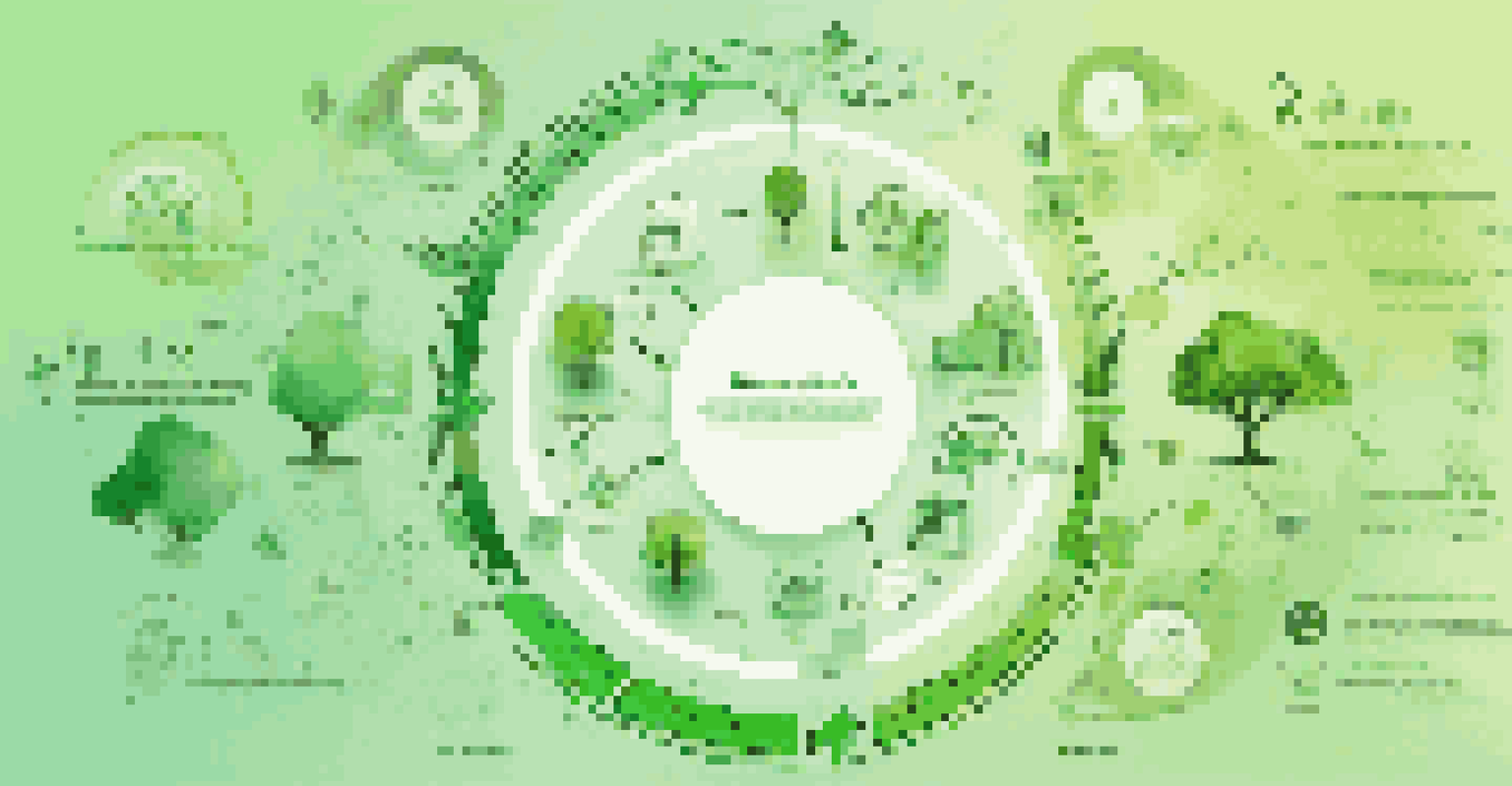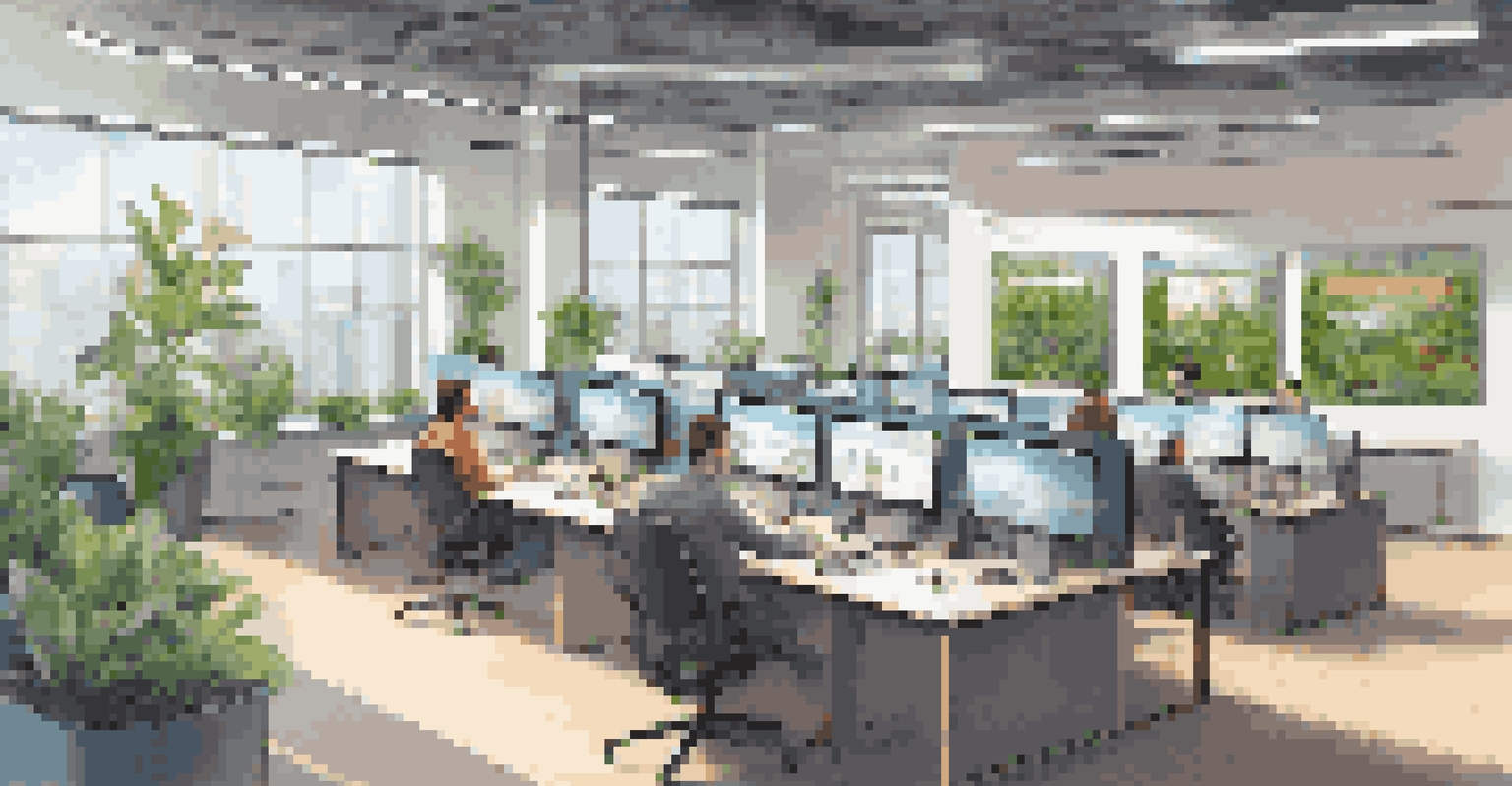Integrating Sustainability into Software Development Life Cycle

Understanding Sustainability in Software Development
Sustainability in software development refers to practices that minimize environmental impact while ensuring long-term viability. This concept is increasingly crucial as software solutions become integral to various industries. By adopting sustainable practices, developers can create applications that not only serve immediate user needs but also contribute positively to the planet.
Sustainability is no longer about doing less harm. It's about doing more good.
Think of sustainability as a mindset that encourages developers to consider resources and energy consumption throughout the software lifecycle. It’s not just about creating efficient code; it’s about making choices that align with environmental stewardship. This can include using energy-efficient coding practices and considering the ecological footprint of the hosting environments.
Integrating sustainability doesn’t have to be overwhelming; it can start with small, impactful changes. For instance, using cloud services that prioritize green technology or optimizing algorithms for better performance can make a significant difference. Each step taken towards sustainability reflects a commitment to a healthier planet.
The Role of the Software Development Life Cycle (SDLC)
The Software Development Life Cycle (SDLC) is a structured process that guides teams through the development of software from inception to deployment. Each phase of the SDLC presents unique opportunities to incorporate sustainable practices. By understanding these phases, teams can identify where to make changes that will lead to a more sustainable outcome.

For example, during the planning phase, teams can assess the project’s environmental impact and set sustainability goals. In the design phase, choices about architecture and technology can prioritize low-energy solutions. By embedding sustainability into each stage, teams cultivate a culture of responsibility that extends beyond just software delivery.
Embrace Sustainability Mindset
Sustainability in software development encourages developers to consider environmental impacts throughout the entire software lifecycle.
Moreover, sustainability in the SDLC is not merely a checklist item; it’s a continuous journey. Teams can revisit their practices regularly, ensuring that sustainability becomes an integral part of their development ethos. This approach fosters innovation while reducing environmental harm.
Sustainable Practices in Requirement Gathering
The requirement gathering phase is crucial for laying a solid foundation for sustainable software. By engaging stakeholders in discussions about environmental goals, teams can gather requirements that emphasize sustainability. This not only aligns the project with broader organizational goals but also resonates with users who value eco-friendly solutions.
The greatest threat to our planet is the belief that someone else will save it.
For instance, consider a project aimed at developing a travel application. By integrating features that promote public transport options or carbon offset calculations, the application can contribute to reduced carbon footprints. Such insights gathered during requirements can lead to innovative features that appeal to environmentally conscious users.
By prioritizing sustainability in requirements, teams can direct their design and development efforts towards solutions that have a measurable positive impact. This proactive approach encourages collaboration among stakeholders, ensuring everyone is invested in achieving sustainable outcomes.
Eco-Friendly Design and Architecture Choices
The design and architecture phase is a critical juncture where sustainability can be baked into the software. Developers can choose frameworks and tools that are not only effective but also energy-efficient. For instance, selecting microservices architecture can lead to more efficient resource utilization compared to monolithic applications.
Moreover, leveraging open-source technologies can reduce the need for extensive resources, as these solutions often have community support and are regularly optimized for performance. By designing software with sustainability in mind, teams can minimize waste and energy consumption throughout the application’s lifecycle.
Integrate Sustainability in SDLC
Incorporating sustainable practices at every phase of the Software Development Life Cycle (SDLC) fosters a culture of environmental responsibility.
It's also essential to consider the user interface and experience (UI/UX) design. Creating intuitive and efficient interfaces reduces the time users spend on tasks, indirectly lowering energy consumption. Sustainable design ultimately leads to a better user experience while supporting environmental goals.
Development Practices That Promote Sustainability
During the development phase, teams can adopt practices that enhance sustainability. For example, using version control systems helps manage code efficiently, reducing redundancy and waste. Additionally, implementing coding standards that prioritize performance can lead to less energy consumption during execution.
Another practice is to automate testing and deployment processes. Automation not only speeds up development but also reduces the likelihood of errors, which can lead to wasted resources. By ensuring that code is clean and efficient, teams can create software that performs well without unnecessary resource consumption.
Furthermore, encouraging remote work and collaboration tools can reduce commuting-related emissions. By embracing flexible work arrangements, software teams can contribute to a more sustainable work culture while maintaining productivity.
Testing and Quality Assurance for Sustainability
The testing phase is vital for ensuring that the software meets both functional and sustainability goals. Quality assurance should include assessments of energy consumption and performance under various conditions. By identifying inefficiencies, teams can optimize their applications to run more sustainably.
For example, using automated testing tools can help evaluate the software's impact on system resources. These tools can simulate different scenarios to measure energy use, allowing teams to make informed adjustments. Sustainability-focused testing not only enhances the product but also contributes to long-term operational efficiency.
Measure and Communicate Impact
Tracking and sharing sustainability metrics helps teams demonstrate their commitment to eco-friendly practices and inspires others to follow suit.
Moreover, adopting a circular testing approach, where feedback loops are established for continuous improvement, can further enhance sustainability. This practice allows teams to make real-time adjustments based on performance and environmental impact, fostering a culture of accountability.
Deployment Strategies for Sustainable Software
Deployment is the final phase of the SDLC, but it’s also a crucial moment to reinforce sustainability. Teams can choose deployment environments that prioritize renewable energy sources or utilize virtualized servers to optimize resource usage. These decisions can significantly reduce the carbon footprint of the software.
Additionally, employing containerization technologies, like Docker, can lead to more efficient resource allocation. By running multiple applications on the same server, containerization minimizes waste and maximizes performance, all while maintaining flexibility in deployment.

It's also essential to consider ongoing maintenance and updates post-deployment. By establishing a framework for regular updates that focus on performance improvements and energy efficiency, teams can ensure that their software remains sustainable throughout its lifecycle.
Measuring and Communicating Sustainability Impact
Finally, measuring the impact of sustainability initiatives is crucial for understanding their effectiveness. Teams can establish key performance indicators (KPIs) related to energy consumption, resource usage, and user engagement. By tracking these metrics, teams can see the tangible benefits of their sustainable practices.
Furthermore, communicating these results to stakeholders and users fosters transparency and builds trust. Sharing success stories and sustainability metrics can enhance the brand’s reputation and encourage more organizations to adopt eco-friendly practices. It’s about creating a narrative that resonates with users who care about the environment.
In conclusion, sustainability in software development is not a one-time effort but a continuous commitment. By measuring and communicating impact, teams can inspire others to join the movement toward greener technology, ensuring that their software contributes to a more sustainable future.